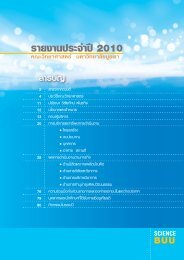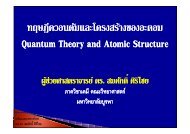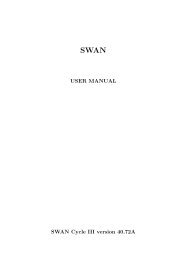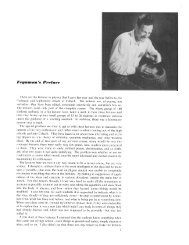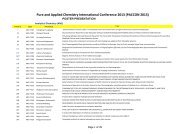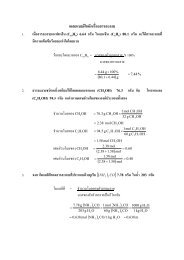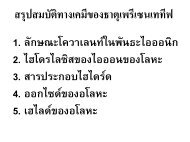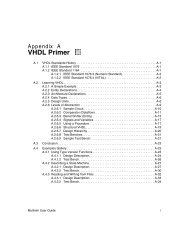Journal of Chromatography A Method for determination of fatty acid ...
Journal of Chromatography A Method for determination of fatty acid ...
Journal of Chromatography A Method for determination of fatty acid ...
Create successful ePaper yourself
Turn your PDF publications into a flip-book with our unique Google optimized e-Paper software.
<strong>Journal</strong> <strong>of</strong> <strong>Chromatography</strong> A, 1216 (2009) 8545–8548<br />
Contents lists available at ScienceDirect<br />
<strong>Journal</strong> <strong>of</strong> <strong>Chromatography</strong> A<br />
journal homepage: www.elsevier.com/locate/chroma<br />
<strong>Method</strong> <strong>for</strong> <strong>determination</strong> <strong>of</strong> <strong>fatty</strong> <strong>acid</strong> amides in polyethylene packaging<br />
materials—Gas chromatography/mass spectrometry<br />
Gang Lv a,b,∗ , Libing Wang a , Jun Liu a , Shufen Li b<br />
a Technical Center <strong>for</strong> Safety <strong>of</strong> Industrial Products, Tianjin Entry-Exit Inspection and Quarantine Bureau, No. 6 Pukou Road, Hexi District, Tianjin 300042, China<br />
b Institute <strong>of</strong> Chemical and Engineering, Tianjin University, No. 92, Weijin Road, Nankai District, Tianjin 300072, China<br />
article<br />
info<br />
abstract<br />
Article history:<br />
Received 7 January 2009<br />
Received in revised <strong>for</strong>m<br />
10 September 2009<br />
Accepted 2 October 2009<br />
Available online 8 October 2009<br />
Keywords:<br />
Fatty <strong>acid</strong> amides<br />
Gas chromatography/mass spectrometry<br />
Pressurized solvent extraction<br />
Derivation<br />
A new method <strong>for</strong> <strong>determination</strong> <strong>of</strong> <strong>fatty</strong> <strong>acid</strong> amides in polyethylene packaging film was developed<br />
using gas chromatography/mass spectrometry (GC/MS). Liquid extraction, Soxhlet extraction ultrasonicassisted<br />
extraction and pressurized solvent extraction (PSE) methods were compared and the results<br />
showed that pressurized solvent extraction was the best <strong>for</strong> extracting these compounds. After extraction,<br />
solvent was blown by nitrogen and a trifluoroethyl derivation step was carried out. The derivative<br />
compounds were identified and quantified by GC/MS using an HP-Innowax column. The retention times<br />
were 6.20 min <strong>for</strong> derivative hexadecanoamide, 8.56 min <strong>for</strong> derivative octadecanamide, 8.84 min <strong>for</strong><br />
derivative oleamide and 13.68 min <strong>for</strong> derivative erucamide, respectively. The detection limits were<br />
61.0 ng g −1 , 74.0 ng g −1 , 103.0 ng g −1 , and 105.0 ng g −1 , respectively, and the linearity were good. The proposed<br />
method was applied satisfactorily to determine these chemicals in different types <strong>of</strong> polyethylene<br />
samples.<br />
© 2009 Elsevier B.V. All rights reserved.<br />
1. Introduction<br />
Slip agents, such as <strong>fatty</strong> <strong>acid</strong> amides, were used in polyethylene<br />
(PE) to bloom to the surface once the film has been produced<br />
and reduce friction coefficients during extrusion, injection molding<br />
and compression molding [1]. The level <strong>of</strong> <strong>fatty</strong> <strong>acid</strong> amides in<br />
the polymers is rather low, normally; the concentration is between<br />
1% and several percent depending on the type <strong>of</strong> polymers and the<br />
processing conditions [2].<br />
According to the EU Directive 2007/42/EC, the total migration<br />
limits <strong>of</strong> <strong>fatty</strong> <strong>acid</strong> amides are 2 mg/dm 2 . The <strong>fatty</strong> <strong>acid</strong> amides<br />
are oil insoluble, hydrophobic and nonvolatile compounds, the<br />
characters <strong>of</strong> which show that they are difficult <strong>for</strong> the extraction<br />
procedure and detection procedure.<br />
Traditionally, the extraction <strong>of</strong> <strong>fatty</strong> <strong>acid</strong> amides from polymers<br />
has been carried out by Soxhlet extraction, ultrasonic-assisted<br />
extraction and supercritical fluid extraction [3–9]. Since <strong>fatty</strong> <strong>acid</strong><br />
amides are insoluble in most <strong>of</strong> the solvents, the selection <strong>of</strong> solvent<br />
is a key step during the extraction.<br />
Studies have shown that slip agents have potential toxicity to<br />
cause skin irritant and erucamide is apparently hydrolysed to erucic<br />
<strong>acid</strong>, which can produce heart damage. The analysis <strong>of</strong> <strong>fatty</strong> <strong>acid</strong><br />
∗ Corresponding author at: Technical Center <strong>for</strong> Safety <strong>of</strong> Industrial Products,<br />
Tianjin Entry-Exit Inspection and Quarantine Bureau, No. 6 Pukou Road, Hexi District,<br />
Tianjin 300042, China. Tel.: +86 22 83326947; fax: +86 22 23395372.<br />
E-mail address: ganglvchen@sohu.com (G. Lv).<br />
amides in polymers is <strong>of</strong> great significance due to wide application<br />
<strong>of</strong> polyethylene film in food and medical packaging. In recent<br />
years, there have been some studies focusing on the analysis <strong>of</strong><br />
<strong>fatty</strong> <strong>acid</strong> amides, <strong>for</strong> example, Mir Ali Farajzadeh used HPLC and<br />
GC methods to determine the lubricants and evaluate analysis <strong>of</strong><br />
real samples <strong>of</strong> polyethylene [2], Alvaro Garrido-Lopez compared<br />
three gas chromatography methods in determining the slip agents<br />
in polyethylene (PE) film [10]. These articles revealed some appropriate<br />
ways to determine slip agents in the PE materials, but some<br />
deficiency remains, <strong>for</strong> example, the low detection limit is relatively<br />
high. In this paper, trifluoroethyl acetylation was carried out be<strong>for</strong>e<br />
the slip agents were injected into the GC/MS. The results showed<br />
that the method proposed can be used to monitor slip agents in<br />
food and medical packaging materials.<br />
2. Experimental<br />
2.1. Apparatus and s<strong>of</strong>tware<br />
All chromatographic measurements were per<strong>for</strong>med with an<br />
Agilent system comprised <strong>of</strong> a 6890N Gas Chromatograph fitted<br />
with an Agilent 7683 auto-sampler, a split–splittless injector<br />
<strong>for</strong> capillary columns and a 5973N mass spectrometer (Agilent<br />
Technology, USA). Auto-tune was carried out with perfluorotributylamine<br />
to enhance the sensitivity <strong>of</strong> GC/MS, and a<br />
complete spectrum mode (SCAN) was applied to ascertain the peak<br />
<strong>of</strong> the target components; selected ion monitoring (SIM) modes<br />
0021-9673/$ – see front matter © 2009 Elsevier B.V. All rights reserved.<br />
doi:10.1016/j.chroma.2009.10.008
8546 G. Lv et al. / J. Chromatogr. A 1216 (2009) 8545–8548<br />
Table 1<br />
Optimized analytical conditions <strong>for</strong> derivative <strong>fatty</strong> <strong>acid</strong> amides by GC/MS.<br />
GC<br />
MS<br />
Instrument Agilent 6890 Instrument Agilent 5973<br />
Column HP-5MS 30 m × 0.25 mm × 0.25 m Ionization EI<br />
Oven temperature Set at 200 ◦ C <strong>for</strong> 5 min, then increase to 250 ◦ C at rate <strong>of</strong> 15 ◦ C/min, and keep <strong>for</strong> 5 min Energy 70 eV<br />
Flow rate 1 mL/min SCAN 50–400 amu<br />
SIM<br />
57 amu, 97 amu, and 124 amu<br />
Injection volume 1 L Solvent delay 4.0 min<br />
Carry gas He (99.999%)<br />
were applied to determine the amount <strong>of</strong> <strong>fatty</strong> <strong>acid</strong> amides in packaging<br />
materials. The optimized analytical conditions are given in<br />
Table 1.<br />
Chemstation s<strong>of</strong>tware (Rev.D.00.01, Agilent Technology, USA)<br />
designed <strong>for</strong> a 5973N mass selective detector was used <strong>for</strong> data<br />
acquisition, and Minitab s<strong>of</strong>tware (Rev15, TechMax In<strong>for</strong>mation<br />
Technology Co., Ltd.) was used to per<strong>for</strong>m regression analysis.<br />
2.2. Materials and reagents<br />
Hexadecanoamide, octadecanamide, oleamide (cis-9-<br />
octadecenoamide) and erucamide (cis-13-docosenoamide) were<br />
purchased from Tokyo Kasei Kogyo Co., Ltd., Tokyo, Japan. Trifluoroacetic<br />
anhydride is purchased from Sigma–Aldrich. Methanol,<br />
isopropanol, chlor<strong>of</strong>orm and hexane were <strong>of</strong> HPLC grade and<br />
purchased from Merck Inc., Darmstadt, Germany. The water used<br />
in the experiments was ultra pure and the polyethylene packaging<br />
materials are bought in local shop.<br />
2.3. Sample treatment and extraction procedure<br />
Polyethylene (PE) packaging material samples were cut approximately<br />
to 1 cm 2 by scissors, then the samples were extracted with<br />
isopropanol and chlor<strong>of</strong>orm complex solvents (1:1, v:v) by techniques<br />
<strong>of</strong> liquid extraction Soxhlet extraction, ultrasonic-assisted<br />
extraction and pressurized solvent extraction, respectively. The<br />
parameters <strong>of</strong> the three different methods were listed in Table 2.<br />
After the extractions, the extracts were blown to dry by nitrogen<br />
gas.<br />
It was shown that the nonvolatility presented by <strong>fatty</strong> <strong>acid</strong><br />
amides make them unsuitable <strong>for</strong> directly detection by GC/MS. In<br />
order to improve volatility, sensitivity and per<strong>for</strong>mance <strong>of</strong> the chromatographic<br />
response, a previous derivation step was investigated.<br />
Trifluoroethyl acetylation is a suitable procedure <strong>for</strong> alcohols,<br />
organic <strong>acid</strong>s and other amines [11], and trifluoroacetic anhydride<br />
is <strong>of</strong>ten used as a derivative reagent.<br />
Fig. 1 shows the total ion current chromatogram <strong>of</strong> <strong>fatty</strong> <strong>acid</strong><br />
amides (Fig. 1a) and their derivatives (Fig. 1b). The identification <strong>of</strong><br />
the peaks was carried out by comparing retention times and also<br />
by the search engine <strong>of</strong> GC/MS library (NIST), and the mass spectra<br />
obtained in scan mode are shown in Fig. 2. Octadecanamide,<br />
and oleamide coeluted be<strong>for</strong>e derivative procedure was carried<br />
out, as shown in Fig. 1(a). The chromatographic per<strong>for</strong>mance <strong>of</strong> the<br />
<strong>fatty</strong> <strong>acid</strong> amides improved significantly after derivation, <strong>of</strong> which<br />
peak 1, peak 2, peak 3 and peak 4 represent derivative hexadecanoamide,<br />
derivative octadecanamide, derivative oleamide and<br />
derivative erucamide, respectively.<br />
3.2. Extraction procedure<br />
3.2.1. The selection <strong>of</strong> extraction solvents<br />
The lack <strong>of</strong> solubility <strong>of</strong> <strong>fatty</strong> <strong>acid</strong> amides in most <strong>of</strong> the<br />
solvents was the main drawback to overcome <strong>for</strong> extraction procedure<br />
and analytical method developments. In order to select<br />
the best extraction solvents, the efficiency <strong>of</strong> different reagents<br />
2.4. Derivative method<br />
To the vials containing the dried residues, a volume <strong>of</strong> 100 L<br />
<strong>of</strong> trifluoroacetic anhydride was added and 1.0 mL <strong>of</strong> CHCl 3 was<br />
added into the vials. Then the vials were closed and mixed thoroughly<br />
<strong>for</strong> 1 min using a vortex system. The derivative reaction was<br />
per<strong>for</strong>med at 40 ◦ C in a water bath <strong>for</strong> 30 min. Then, the derivatives<br />
were allowed to cool to room temperature and diluted to proper<br />
concentrations with CHCl 3 , the solutions were subjected to GC/MS<br />
analysis. The compounds were demonstrated to be stable within 2<br />
days.<br />
2.5. GC/MS analysis<br />
The instrumental parameters are listed in Table 1, and the samples<br />
were introduced into the GC/MS system by an auto-sampler.<br />
3. Results and discussion<br />
3.1. Derivation and GC/MS analysis <strong>of</strong> <strong>fatty</strong> <strong>acid</strong> amides<br />
Fig. 1. Total ion current chromatogram <strong>of</strong> standard compounds and derivatives<br />
(a) 1: hexadecanoamide, 2: octadecanamide, 3: oleamide, and 4: erucamide<br />
(100.0 mg L −1 ); (b) 1: derivative hexadecanoamide, 2: derivative octadecanamide,<br />
3: derivative oleamide, and 4: derivative erucamide (1.0 mg L −1 ).
G. Lv et al. / J. Chromatogr. A 1216 (2009) 8545–8548 8547<br />
Table 2<br />
The parameters <strong>of</strong> different extractions using isopropanol and chlor<strong>of</strong>orm complex solvents (1:1, v:v).<br />
Extraction method Sample weight (g) Time (h) Temperature ( ◦ C) Pressure (bar)<br />
Liquid extraction 1.0 5.0 50 0<br />
Soxhlet extraction 1.0 5.0 60 0<br />
Ultrasonic-assisted extraction 1.0 0.5 50 0<br />
Pressurized solvent extraction a 1.0 0.5 90 100<br />
a Cell volume, 33 mL; static mode, 2 cycles; flush volume, 100% and purge time, 120 s.<br />
Fig. 2. Mass spectra obtained in scan mode <strong>for</strong> derivative <strong>fatty</strong> <strong>acid</strong> amides: (a) hexadecanoamide, (b) octadecanamide, (c) oleamide and (d) erucamide.<br />
was studied using pressurized solvent extraction, as shown in<br />
Fig. 3.<br />
Slip agents were extracted from the polymer with different solvents.<br />
After filtration and derivation, the extracts were injected<br />
in duplicate into the GC/MS system, and the results showed that<br />
the presence <strong>of</strong> 1:1 <strong>of</strong> isopropanol in chlor<strong>of</strong>orm led to the best<br />
extraction efficiency.<br />
3.2.2. Extraction efficiency<br />
To compare the extraction efficiency, liquid extraction, Soxhlet<br />
extraction, ultrasonic-assisted extraction and pressurized solvent<br />
extraction (PSE) were used to determine the known amount <strong>of</strong><br />
<strong>fatty</strong> <strong>acid</strong> amides in PE packaging film (0.5% <strong>of</strong> hexadecanoamide,<br />
Fig. 3. Extraction <strong>of</strong> slip agents in various solvents.<br />
octadecanamide, oleamide and erucamide in PE, respectively), <strong>of</strong><br />
which the thickness was 20 m. The recoveries <strong>of</strong> the <strong>fatty</strong> <strong>acid</strong><br />
amides were assessed by adding known amounts <strong>of</strong> standards to<br />
the packaging materials, <strong>of</strong> which the initial concentrations <strong>of</strong> the<br />
analytes already present in the samples. The <strong>fatty</strong> <strong>acid</strong> amides were<br />
added during the mixing and extrusion stage <strong>of</strong> the PE packaging<br />
film, and after 2 days the <strong>fatty</strong> <strong>acid</strong> amides would migrate through<br />
the polymer bulk to the surface.<br />
The recoveries were calculated based on the detected amount<br />
divided by the known amount and multiplied by 100 (to calculate<br />
the percentage), as shown in Table 3. In general, the recovery should<br />
range from 90% to 110% <strong>for</strong> a quantitative method. The recoveries<br />
<strong>of</strong> <strong>fatty</strong> <strong>acid</strong> amides ranged from 102% to 147% <strong>for</strong> pressurized solvent<br />
extraction. This is due to some <strong>of</strong> the <strong>fatty</strong> <strong>acid</strong> amides migrate<br />
from the polytetrafluroethylene (PTFE) pipe line into the solvents,<br />
and cause the test results a little high. In the mean time, the pressurized<br />
solvent extraction (PSE) is time-saving and solvent-saving.<br />
When the pipe line free <strong>of</strong> <strong>fatty</strong> <strong>acid</strong> amine was used, the recoveries<br />
improved significantly, and ranged from 94% to 105%.<br />
The slip agents have a designed incompatibility with the bulk<br />
polymer so that they are not bonded into the bulk but are free to<br />
migrate. Since the packaging film was only 20 m thin, the recoveries<br />
ranged from 94% to 105% <strong>for</strong> the four <strong>fatty</strong> <strong>acid</strong> amides. The<br />
recoveries decreased as the carbon chain extended, because the slip<br />
agents can be tuned by increasing the molecule chain length by<br />
adding or subtracting carbon atoms. Adding more atoms increases<br />
the chain length and slows down the speed <strong>of</strong> migration [12]. For<br />
example, erucamides are longer chain, more heat stable and more<br />
oxidation than oleamides and with a lower vapor pressure create<br />
fewer volatiles during high temperature processing. The oleamides<br />
migrate through to the surface more quickly.
8548 G. Lv et al. / J. Chromatogr. A 1216 (2009) 8545–8548<br />
Table 3<br />
The recoveries <strong>of</strong> target compounds obtained by different extraction.<br />
Extraction mode Hexadecanoamide (%) Octadecanamide (%) Oleamide (%) Erucamide (%)<br />
Liquid extraction 72 ± 9 101 ± 3 91 ± 7 91 ± 6<br />
Soxhlet extraction 87 ± 6 132 ± 11 111 ± 2 131 ± 8<br />
Ultrasonic-assisted extraction 79 ± 5 105 ± 7 104 ± 4 91 ± 9<br />
Pressurized solvent extraction 102 ± 2 147 ± 8 134 ± 9 114 ± 3<br />
Pressurized solvent a extraction 105 ± 3 101 ± 4 96 ± 3 94 ± 3<br />
a The PSE pipe line free <strong>of</strong> target components was used.<br />
Table 4<br />
Analytical parameters <strong>of</strong> the GC/MS method <strong>for</strong> derivative <strong>fatty</strong> <strong>acid</strong> amides.<br />
Parameters Derivative hexadecanoamide Derivative octadecanamide Derivative oleamide Derivative erucamide<br />
Linearity range (gg −1 ) 0.2–100.0 0.6–100.0 0.4–100.0 0.4–100.0<br />
Correlation coefficient (r 2 ) 0.9968 0.9988 0.9991 0.9983<br />
Detection limit a (ng g −1 ) 61.0 74.0 103.0 105.0<br />
RSD (%, n = 5) 1.88 2.34 1.96 2.53<br />
a The detection limits were calculated by using signal/noise = 3.<br />
Table 5<br />
The results <strong>of</strong> <strong>fatty</strong> <strong>acid</strong> amides in polyethylene packaging materials.<br />
Samples Hexadecanoamide Octadecanamide Oleamide Erucamide<br />
Cont. (gg −1 ) RSD (%, n = 3) Cont. (gg −1 ) RSD (%, n = 3) Cont. (gg −1 ) RSD (%, n = 3) Cont. (gg −1 ) RSD (%, n =3)<br />
1 97.0 3.0 203 6.1 389 5.0 201 8.1<br />
2 ND 7.1 ND 3.3 243 5.1 213 5.7<br />
3 ND 8.3 109 3.9 414 11.3 208 8.7<br />
4 116 5.9 327 11.0 969 3.9 222 3.0<br />
5 108 10.2 219 4.2 416 8.8 337 6.9<br />
3.2.3. Analytical per<strong>for</strong>mance<br />
In order to study the relative standard deviation associated to<br />
the extraction and the detection <strong>of</strong> <strong>fatty</strong> <strong>acid</strong> amides in PE film by<br />
PSE and GC/MS, five aliquots <strong>of</strong> the same sample were extracted<br />
under the PSE procedure and the GC/MS conditions mentioned<br />
above. Quantitative parameters, such as the linear range, correlation<br />
coefficient and detection limit were also investigated. The<br />
results are given in Table 4. The extracted standard curves obtained<br />
in the linear ranges showed excellent linearities with coefficients<br />
<strong>of</strong> correlation that were in variably greater than 0.99. Besides, the<br />
relative standard deviation <strong>of</strong> the chromatographic <strong>determination</strong><br />
was less than 3.0%, which demonstrate good method precision.<br />
3.3. Determination <strong>of</strong> <strong>fatty</strong> <strong>acid</strong> amides in packaging materials<br />
To check the suitability <strong>of</strong> the method <strong>for</strong> the analysis <strong>of</strong> slip<br />
agents, the method was applied to determine these analytes in five<br />
PE film samples. The concentrations and RSD (%, n = 3) obtained<br />
<strong>for</strong> the target compounds were listed in Table 5. The obtained<br />
result showed that the selected samples contained high amounts <strong>of</strong><br />
amides. Hexadecanoamide and octadecanamide were not detected<br />
in sample 2 and hexadecanoamide was not detected in sample 3.<br />
The RSD was less than 10% in all cases.<br />
4. Conclusions<br />
A PSE-GC/MS method to determine <strong>fatty</strong> <strong>acid</strong> amides in<br />
polyethylene film has been established. The main advantage <strong>of</strong><br />
the proposed method is the ability to determine mixtures <strong>of</strong> the<br />
four <strong>fatty</strong> <strong>acid</strong> amide, and the low detection limits are relatively<br />
lower than the method reported [2,3]. The PSE method also reduces<br />
extraction time and solvent compared with traditional extraction<br />
methods, such as liquid extraction, Soxhlet extraction and ultrasonic<br />
extraction. PSE method is based on the use <strong>of</strong> solvent heated<br />
above its boiling point in pressurized system in order to accelerate<br />
the extraction process and enhance the solubility <strong>of</strong> the target<br />
components. The speed <strong>of</strong> migration is also affected by the bulk<br />
polymer structure. The slip agents are solubilized into the polymer<br />
when it is molten but as the polymer cools it is precipitated out <strong>of</strong><br />
the polymer that crystallizes and acts as a lubricant. So, recovery <strong>of</strong><br />
PSE method applied to thin packaging film may be better than that<br />
<strong>of</strong> thick film.<br />
References<br />
[1] O.G. Piringer, A.L. Baner, Plastic Packaging Materials <strong>for</strong> Food-barrier Function,<br />
Mass Transport, 1st ed., Quality Assurance and Legislation, London, 2000.<br />
[2] M.A. Farajzadeh, M. Ebrahimi, A. Ranji, Microchim. Acta 153 (2006) 73.<br />
[3] Y. Kawamura, M. Miura, T. Sugita, J. Food Hyg. Soc. Jpn. 37 (1996) 272.<br />
[4] Y. Kawamura, M. Miura, T. Sugita, J. Food Hyg. Soc. Jpn. 38 (1997) 307.<br />
[5] Y. Kawamura, R. Yonezawa, T. Maehara, J. Food Hyg. Soc. Jpn. 41 (2000) 154.<br />
[6] H.J. Vandenburg, A.A. Clif<strong>for</strong>d, K.D. Bartle, Analyst 122 (1997) 101.<br />
[7] R.C. Nielson, J. Liq. Chromatogr. 14 (1991) 503.<br />
[8] A.S. Rawls, D.E. Hirt, J. Vinyl Addit. Technol. 8 (2002) 130.<br />
[9] C.A. Shuler, A.V. Janorkar, Polym. Eng. Sci. 44 (2004) 2247.<br />
[10] A.G. Lopez, V. Esquiu, M.T. Tena, J. Chomatogr. A 1150 (2007) 178.<br />
[11] P.K. Tsai, A. Dell, C.E. Ballou, Biochemistry 82 (1986) 4119.<br />
[12] C.A. Bishop, 49th Annual Technical Conference Proceedings, vol. 505, 2006, p.<br />
7188.





